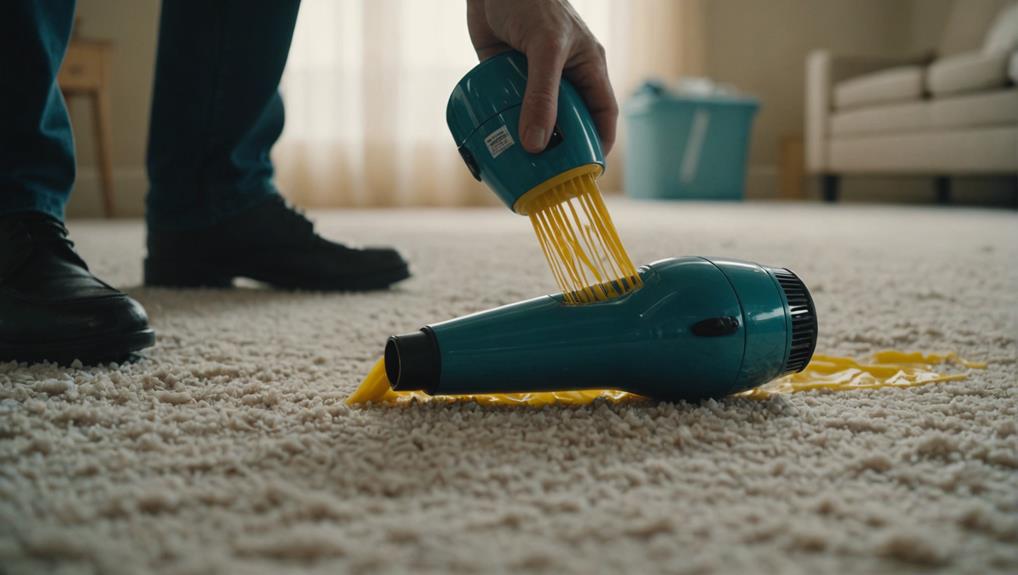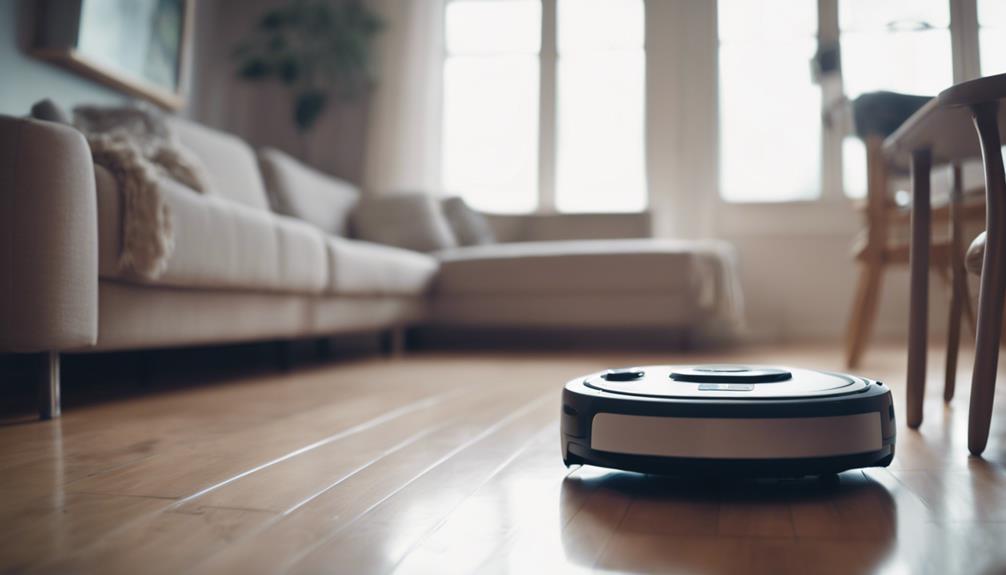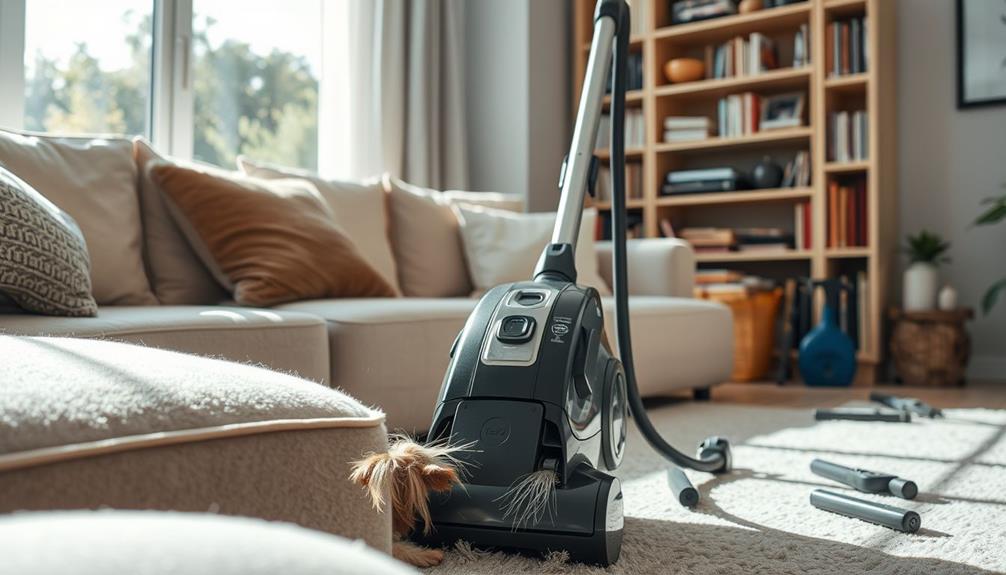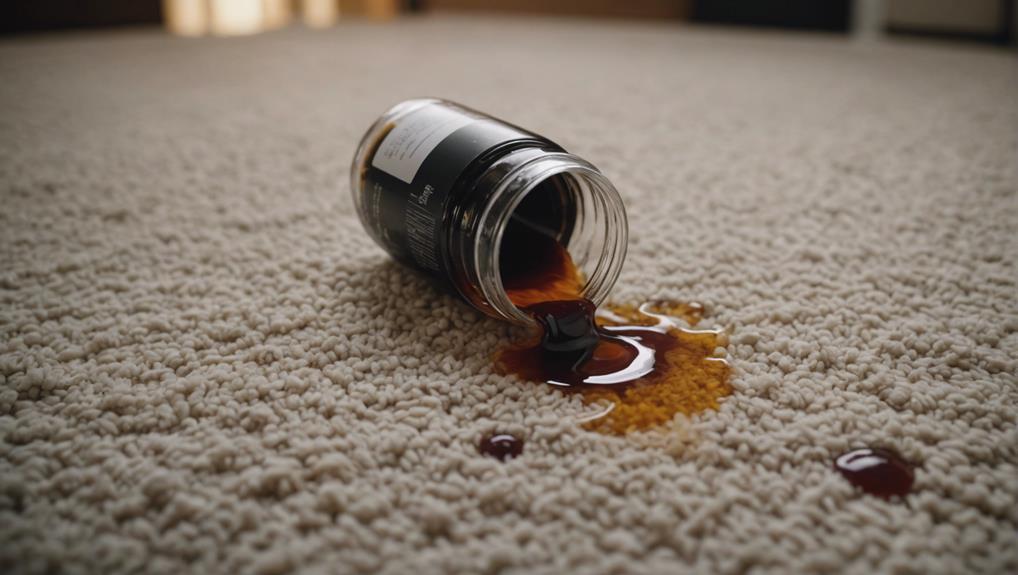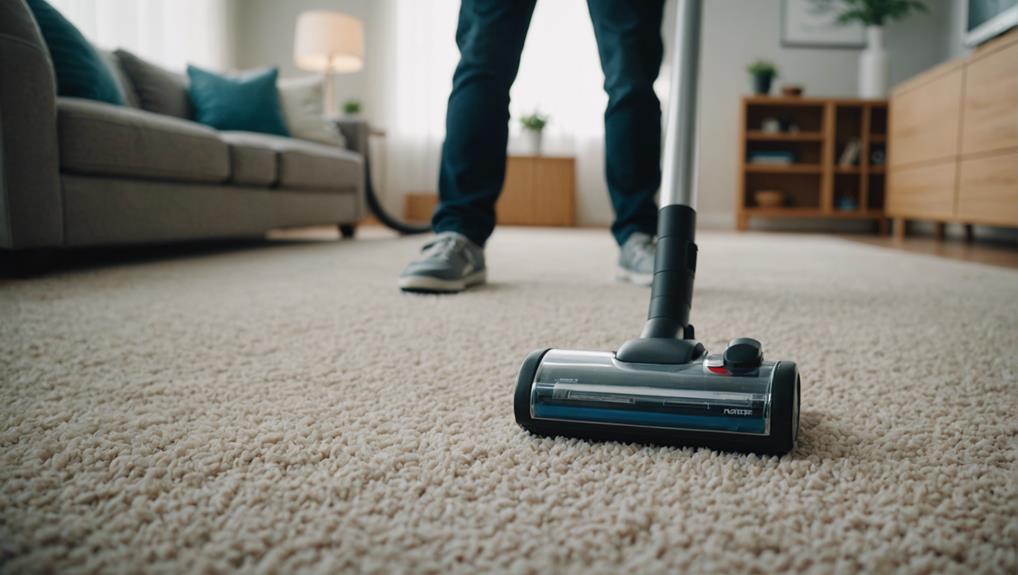For a quick and safe way to remove melted plastic or wax from your carpet, start by allowing it to cool and harden. Carefully scrape off with a dull knife, making sure not to damage the carpet fibers. The credit card scraping method works well for hard-to-reach areas. Address the stain promptly with either the white vinegar solution or the baking soda technique. For tough residue, attempt the plastic bag and spoon trick. Avoid causing damage by refraining from aggressive scraping or using heat sources. These methods ensure a successful and safe removal. Additional steps can offer detailed instructions to help you maintain a clean carpet.
Key Takeaways
- Use ice to freeze, then gently scrape off melted plastic or wax.
- Apply white vinegar solution to dissolve residue, then blot with a cloth.
- Sprinkle baking soda, wait, then vacuum to absorb and remove residue.
- Utilize a plastic bag and spoon to soften and transfer melted material.
- Avoid damaging fibers by using gentle scraping techniques and testing cleaning solutions.
Allow Substance to Cool and Harden
Before attempting to remove melted plastic or wax from your carpet, allow the substance to cool and harden. Allowing the plastic or wax to cool solidifies it, making removal easier. Cooling prevents further spreading or embedding into the carpet fibers. This step is essential in ensuring that the substance doesn't set in, making it harder to remove later on.
By letting it cool down, you're effectively halting its ability to seep deeper into the carpet, simplifying the cleaning process.
When the plastic or wax has cooled and hardened, it can be gently scraped off the carpet using a dull knife or a credit card. Sharp objects should be avoided to prevent damaging the carpet fibers during the removal process. By following this method, you can effectively remove the substance without causing additional harm to your carpet.
Gently Scrape With Dull Knife
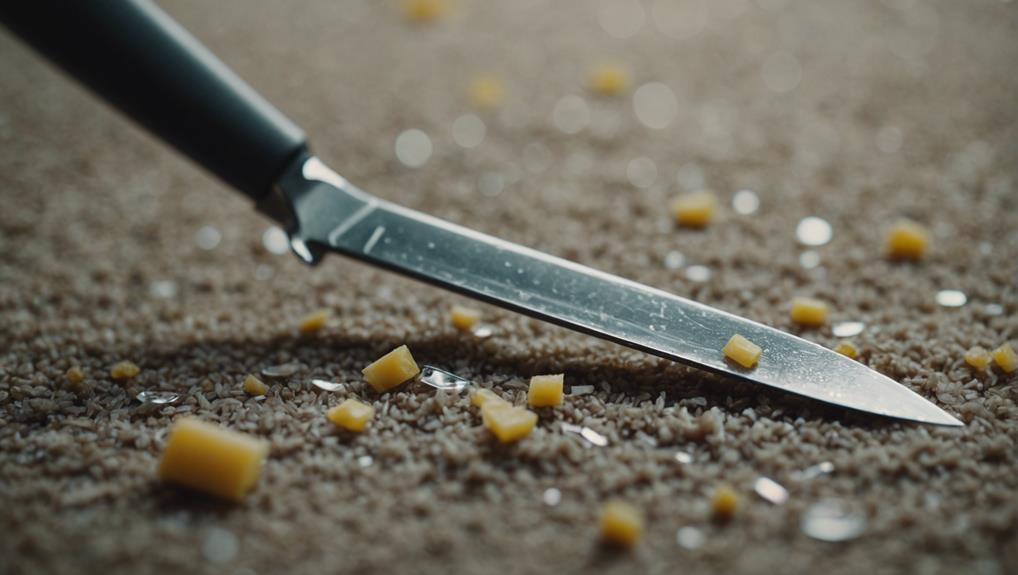
When facing melted plastic or wax on your carpet, gently scrape with a dull knife to lift the residue. Be cautious to avoid causing damage to the carpet fibers while scraping.
This method helps in removing as much of the substance as possible before moving on to the next steps.
Use Ice Method
To remove melted plastic or wax from your carpet using the ice method, gently scrape the frozen substance with a dull knife or credit card.
Here's how you can effectively utilize this technique:
- Place an ice pack or a bag of ice on the melted plastic or wax to freeze it solid.
- Once the substance is frozen, carefully scrape it off the carpet fibers using a dull knife or a credit card.
- Remember to avoid using sharp objects to prevent any damage to the carpet during the removal process.
The ice method is a safe and efficient way to eliminate melted plastic or wax from your carpet without causing further harm. By freezing the substance, you make it easier to lift off without risking any tears or cuts in the carpet. This method is gentle yet effective in restoring your carpet to its original state.
Apply Heat Technique
Consider gently applying heat with an iron to soften melted plastic or wax on your carpet, making it easier to scrape off with a dull knife. The heat from the iron helps loosen the melted substance, allowing you to remove it without causing damage to your carpet.
Once the plastic or wax is softened, gently scrape it with a dull knife to lift it off the carpet fibers. It's important to avoid using sharp objects to prevent any potential harm to the carpet during the removal process.
By combining the use of heat with the scraping technique, you can effectively eliminate the melted plastic or wax from your carpet surface. This method is a safe and efficient way to deal with such spills, ensuring that your carpet remains intact while removing the unwanted substance.
Remember to proceed cautiously and patiently to achieve the best results when using the iron to soften the melted plastic or wax.
Use Credit Card for Scraping

When dealing with melted plastic or wax on your carpet, consider using a credit card for scraping.
The thin and flexible edge of a credit card can help lift off the residue without causing damage.
Be gentle and patient while scraping to guarantee the carpet fibers remain intact.
Credit Card Scraping Method
For removing melted plastic or wax from your carpet, consider utilizing the credit card scraping method. Using a credit card for scraping is effective due to its flexibility and thin edge, which make it ideal for lifting melted substances without damaging the carpet.
Here's how to effectively use the credit card scraping method:
- Gently scrape: Use the credit card to gently scrape off the melted plastic or wax from your carpet fibers.
- Slide carefully: Slide the credit card under the melted plastic or wax and carefully scrape it off in a controlled manner.
- Avoid force: Avoid using excessive force when scraping with a credit card to prevent tearing or fraying the carpet fibers.
Benefits of This Technique
Using a credit card for scraping melted plastic or wax from your carpet offers several advantages that help guarantee a successful removal process. The thin, sturdy edge of a credit card is ideal for this task as it helps guarantee damage to the carpet fibers while allowing for precise scraping of the melted substances.
Additionally, the flexibility of a credit card makes it easy to maneuver in tight spaces and corners where melted plastic or wax may be stuck. This convenience ensures that you can effectively lift off the residues without causing harm to the carpet.
Furthermore, by using a credit card, you can avoid leaving behind any scratches or marks on the carpet surface, maintaining its overall appearance. Overall, the use of a credit card as a scraping tool provides a practical and efficient method for removing melted plastic or wax from your carpet with ease and precision.
Treat the Stain Promptly
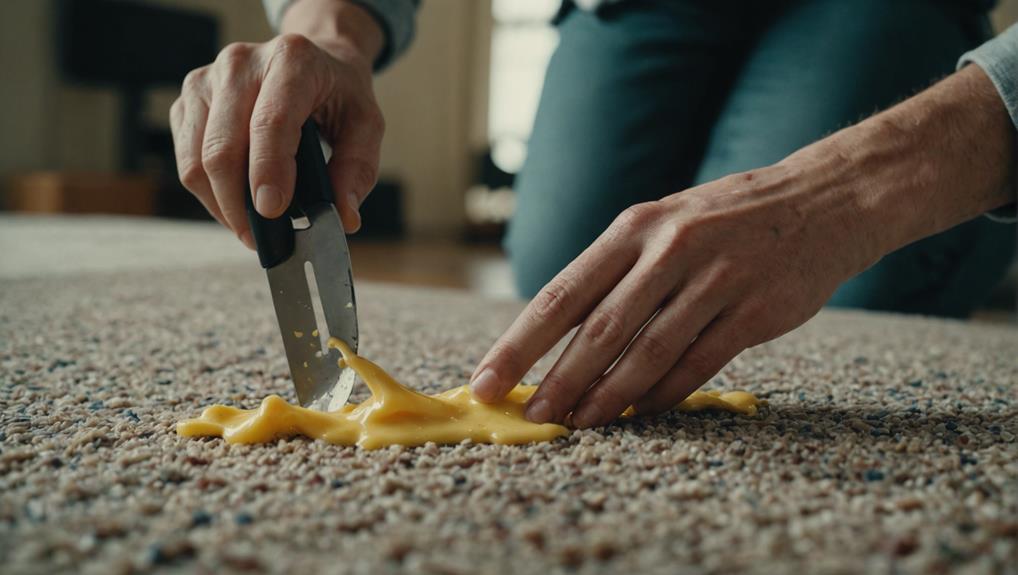
Act promptly when dealing with melted plastic or wax stains on your carpet to prevent them from hardening and becoming more challenging to remove. Here are some essential steps to take when treating the stain promptly:
- Blot the Area: Use a clean cloth or paper towel to gently blot the melted plastic or wax. Avoid rubbing, as this can push the substance further into the carpet fibers.
- Scrape Carefully: If the melted plastic or wax has hardened, carefully scrape off as much as you can with a plastic scraper or a blunt knife. Be cautious not to damage the carpet fibers.
- Apply Heat: Use a hairdryer on a low setting to carefully heat the remaining plastic or wax. Once softened, blot the area again to lift the stain off the carpet fibers.
Iron With a Cloth Method
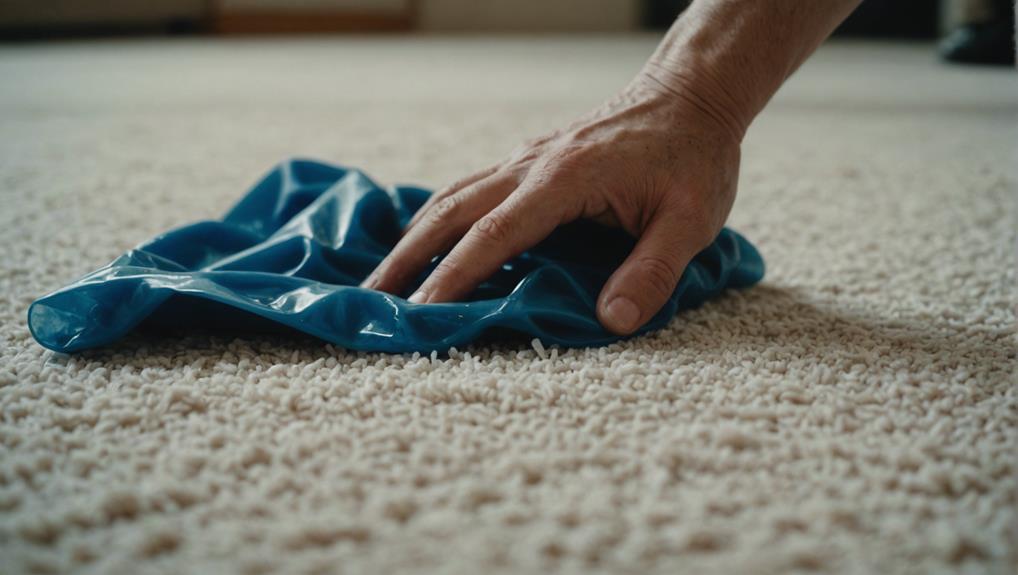
You can utilize the iron with a cloth method to effectively remove melted plastic or wax from your carpet. Start by placing a cloth over the affected area, ensuring complete coverage.
Then, set your iron to a warm temperature and gently press down on the cloth-covered spot. The heat from the iron will help soften the plastic or wax, making it easier to lift off the carpet fibers. Lift the cloth periodically to check if the plastic or wax has transferred onto it.
If so, continue the process until all the melted material is removed.
This method is particularly useful for stubborn plastic or wax stains on your carpet. It allows you to apply controlled heat to the affected area without damaging the carpet fibers.
Remember to be cautious when using the iron to avoid burns or further damage to the carpet. With patience and diligence, the iron with a cloth technique can effectively clean your carpet from melted plastic or wax residues.
Freeze the Wax Technique

To tackle melted plastic or wax spills on your carpet, consider employing the freeze the wax technique as a quick and effective solution. This method involves using cold temperatures to solidify the melted substance, making it easier to remove from the carpet fibers.
Here's how you can effectively use the freeze technique:
- Place an ice pack or a bag of ice wrapped in a cloth directly on the melted wax to freeze it.
- Allow the wax to harden by keeping the ice pack in place for a few minutes.
- Once the wax is frozen, gently scrape it off the carpet using a dull knife or a credit card, being careful not to damage the carpet fibers.
Utilize White Vinegar Solution

To effectively remove melted plastic or wax from your carpet, white vinegar can be a handy solution. Begin by dampening a cloth with white vinegar and gently dabbing it onto the affected area.
The vinegar helps dissolve the residue without harming your carpet fibers, making it easier to lift and clean the affected spot.
Vinegar for Plastic Removal
Consider utilizing a white vinegar solution to effectively remove melted plastic from your carpet fibers. White vinegar can dissolve and lift the plastic residue, making it easier to clean.
Here are some steps to help you effectively use white vinegar for plastic removal:
- Dampen a cloth with white vinegar and gently dab it onto the melted plastic stain to break down the residue.
- Allow the vinegar to sit for a few minutes to effectively dissolve the plastic.
- Blot the area with a clean cloth to lift the dissolved plastic from the carpet fibers.
Steps for Effective Cleaning
Prepare a white vinegar solution by mixing equal parts vinegar and water for an effective cleaning method to remove melted plastic or wax from your carpet.
Dampen a clean cloth with the cleaning solution. Gently dab the cloth onto the melted plastic or wax stain on the carpet. Allow the vinegar solution to work its magic by breaking down the tough residue.
After a few minutes, blot the area with a dry cloth to absorb the loosened residue. Repeat the process if needed until the stain is completely removed and the carpet looks clean once again.
Plastic Bag and Spoon Trick

Cover the melted plastic or wax on your carpet with a plastic bag and press down gently with a spoon to soften the material.
The heat from the spoon helps transfer the melted plastic or wax onto the plastic bag.
Follow these steps to effectively remove the melted residue:
- Place a plastic bag over the affected area.
- Use a spoon to press down gently on the bag, allowing the heat to soften the melted material.
- Repeat the process until all the melted plastic or wax is transferred onto the plastic bag.
Apply Baking Soda Method

To effectively remove melted plastic or wax from your carpet, consider utilizing the baking soda method. Baking soda has the ability to absorb the melted residue effectively.
Begin by sprinkling a generous amount of baking soda over the affected area on the carpet. Allow the baking soda to sit and work its magic for about 15-30 minutes. During this time, the baking soda will absorb the melted plastic or wax from the carpet fibers.
After the waiting period, use a vacuum cleaner to remove the baking soda along with the absorbed residue. If there are still remnants of melted plastic or wax on the carpet after the first attempt, repeat the process until the carpet is completely free of any residue.
The baking soda method is a simple and effective way to remove melted plastic or wax from your carpet without causing any damage to the fibers.
Prevent Harm to Carpet Fibers

Avoid causing damage to your carpet fibers by using gentle removal methods when dealing with melted plastic or wax stains. To prevent harm, follow these tips:
- Avoid harsh scraping or rubbing: Instead, opt for methods like freezing or heating to soften the substance.
- Exercise caution with heat sources: Make sure the iron or heat source is at an appropriate temperature to prevent scorching or melting the carpet fibers.
- Test cleaning solutions: Always select safe solvents for the carpet material to prevent discoloration or damage.
When cleaning up melted plastic or wax, remember that being gentle is key to preserving your carpet's integrity. Consider using a paper bag and a gentle touch to lift the substance without causing further harm. By taking these precautions, you can effectively remove the stain without compromising the quality of your carpet fibers.
Frequently Asked Questions
How Do You Remove Melted Plastic From Carpet?
To remove melted plastic from carpet, gently heat it with a hairdryer, place a paper towel over it, then scrape off the softened plastic using a dull knife. Clean residue with carpet cleaner or rubbing alcohol after testing in a hidden area.
How Do You Get Melting Wax Out of Carpet?
To get melting wax out of your carpet, freeze it with ice, then scrape off the hardened wax with a dull knife. Iron over a paper towel on the stain to absorb melted wax. Blot with alcohol and vacuum.
What Dissolves Melted Plastic?
To dissolve melted plastic, try using acetone or heat to soften it. You can also scrape it off with a putty knife or apply a baking soda paste. Remember to ventilate when using chemicals like acetone.
Does Rubbing Alcohol Remove Wax From Carpet?
Yes, rubbing alcohol effectively removes wax from carpet. It breaks down the residue, making it easier to lift off the surface. Always test a small area first. The alcohol evaporates fast, leaving your carpet clean.
Can the Methods for Removing Carpet Stains With Liquids also Work for Removing Melted Plastic or Wax?
Have you ever wondered if the magic carpet stain removal techniques can also work for removing melted plastic or wax? While these methods are specifically designed for liquid stains on carpets, they can also be effective for removing hardened substances like plastic or wax with a few modifications and extra care.
Conclusion
To sum up, removing melted plastic or wax from your carpet can be a simple process if done correctly. By following these easy steps, you can effectively clean your carpet without causing damage.
Remember, prevention is key to avoiding future mishaps. So next time you find yourself in a sticky situation, don't panic – just grab a credit card and get scraping!
